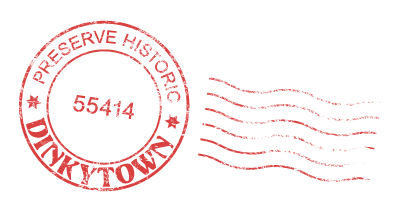Alternative Education
MARSHALL-UNIVERSITY HIGH
1313 5TH ST S.E.
Across the street from the House of Hanson and diagonally from the Ten O’clock Scholar, Marshall-University High students partook fully of the life of Dinkytown.
A former student noted how wonderful it was for teenagers to have a place they could ride their bikes to—their own small-scale city where there was always music, excitement, street characters, poetry, and fantastic conversations “at the Scholar or at Bridgeman’s when the Scholar was closed.”
The last class at Marshall-University High celebrated its 30th reunion the year before the building was demolished in April 2013, for a student housing complex.
Dave Ray
The Marshall-University High records are in the University of Minnesota archives. Among the persons of note who attended Marshall-University High were:
Dave Ray
Dave “Snaker” Ray (1961) was a blues singer and guitarist from St. Paul, Minnesota who was most notably associated with “Spider” John Koerner and Tony "Little Sun" Glover in the early ’50s Folk Revival.
Eric Utne
Eric Utne, founding publisher of the Utne Reader, has spent his career as a journalist, writer, editor, and publisher. He founded the Utne Reader in 1984 and was the founding publisher and editor of the New Age Journal.
Mark Naftalin
Mark Naftalin (ca. 1963) was Minneapolis DFL mayor Art Naftalin's son. Mark played keyboard with the Paul Butterfield Blues Band, with whom he produced four albums including the critically acclaimed East-West. He was instrumental in the blues revival of the late 1960s, moving to San Francisco and hosting a radio program called Mark Naftalin’s Blue Monday.
Freedom Riders
Dave Morton
Dave Morton (ca. 1958) was a folkie, Dinkytown denizen, and one of the Minneapolis crew of Freedom Bus riders in the 1960s. He may have been the first hippie. He has been a poet, musician, and jewelry maker and was close to Bob Dylan in his Dinkytown days.
Diamond Dave Whitaker
Diamond Dave Whitaker is remembered by the San Francisco Bay Guardian newspaper executive editor Tim Redmond as “Mayor of The Haight,” while acknowledging his prominent leadership as community organizer of San Francisco’s beat poets. Dylan historians record that it was Diamond Dave who urged Dylan’s move to New York City
Bonnie Beecher
Bonnie Beecher (1959), now called Jahanara Romney, was a Dylan girlfriend in Dinkytown. She was the possible inspiration for Bob Dylan's "Girl from the North Country."
Arne Brogger
Arne Brogger (1961) became a blues musician's manager and was part of the 1960s Memphis Blues Caravan, the bus that carried a number of the original black Delta blues musicians around the country to visit campuses and other venues.
Barry Hansen
Barry Hansen (1959) became the nationally known disk jockey and record collector "Doctor Demento." Barry now lives in California and is still doing an internet radio show weekly. Nancy Ortenstone is an artist of artist of renown currently in Taos, New Mexico. She has had numerous solo, two-person, and group exhibitions and taught Language Arts at Marshall U HIgh in the mid-1970s.
Heart of the Earth
1206 5th Street S.E.
Heart of the Earth School was a Native American survival school was established as a way of reclaiming the heritage of Native American children. It was established by Clyde Bellecourt, one of the founders of the American Indian Movement (AIM) in 1968.
“If we forget our past, we will never have a future,” Bellecourt said. The school was located in the Henry B. Frey House, an old Minneapolis mansion at 1206 5th Street S.E. in Dinkytown.
Churches and Religious Centers
The churches at the heart of Dinkytown and near the University had a critical role in the transforming social fabric of Dinkytown in the 1950s, 1960s and 1970s—taking leadership in a range of issues from integration, war protest, to communal living.
UNIVERSITY BAPTIST CHURCH
1219 UNIVERSITY AVE S.E.
The Reverend Bill Teska, who leads a small Minneapolis Episcopalian congregation that meets in the University Baptist Church at 1219 University Ave. S.E., and Don Olson, who spent 20 months in federal prison for disrupting draft offices in 1970, led a discussion on Nov. 22, 2014, on the role of religion in the peace and civil rights movements of the 1960s and 1970s.
❦ READ MORE: Dinkytown religions influenced students’ lives
WESLEY FOUNDATION
12TH AVE AND 14TH ST.
Olson says that one of the meeting places was the Wesley Foundation at 12th Avenue and Fourth Street with people who were “very much involved with the draft resistance movement. They served a couple of meals a day at the church, early in the antiwar movement in 1966.
"The early meetings of the Vietnam mobilization against the war began there in the basement. We planned the Draft Information Center and smoked some dope there occasionally.”
NEWMAN CENTER 17TH ST. AND UNIVERSITY AVE S.E.
“The Newman Center at 17th and University was also important,” said Olson. “The Newman Center was more student oriented than the St. Lawrence Church on the other side of Dinkytown. Newman Center was tied not just to the University but to Dinkytown.
The Center brought the Catholic Worker founder in 1963 for a week of talks on campus on Christian anarchism, peace, and service to the poor.” Gene McCarthy was exploring his Catholic beliefs at Newman Center at that time, and Newman Center brought in community organizer Saul Alinsky, who taught people how to protest, and comedian and protestor Dick Gregory.
HILLEL HOUSE
1521 UNIVERSITY AVE S.E.
Rabbi Louis Milgrom, director of the Hillel House for Jewish students, brought in speakers and students to discuss race and religion.




